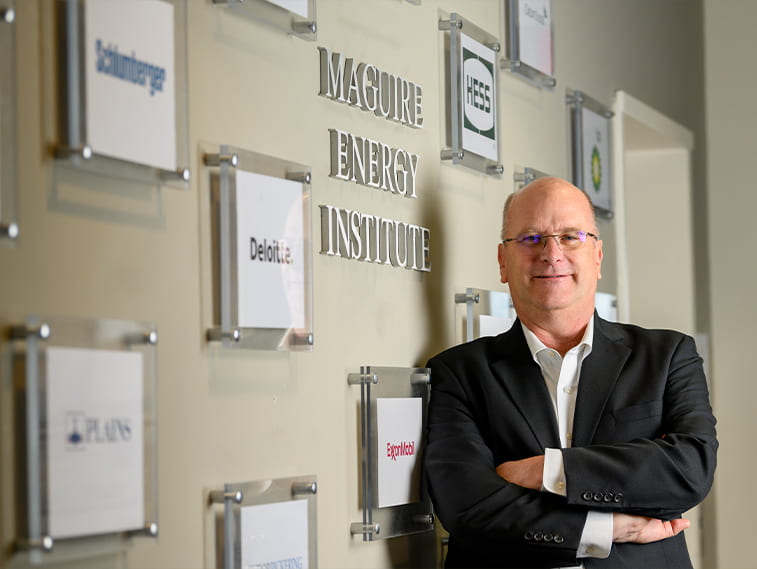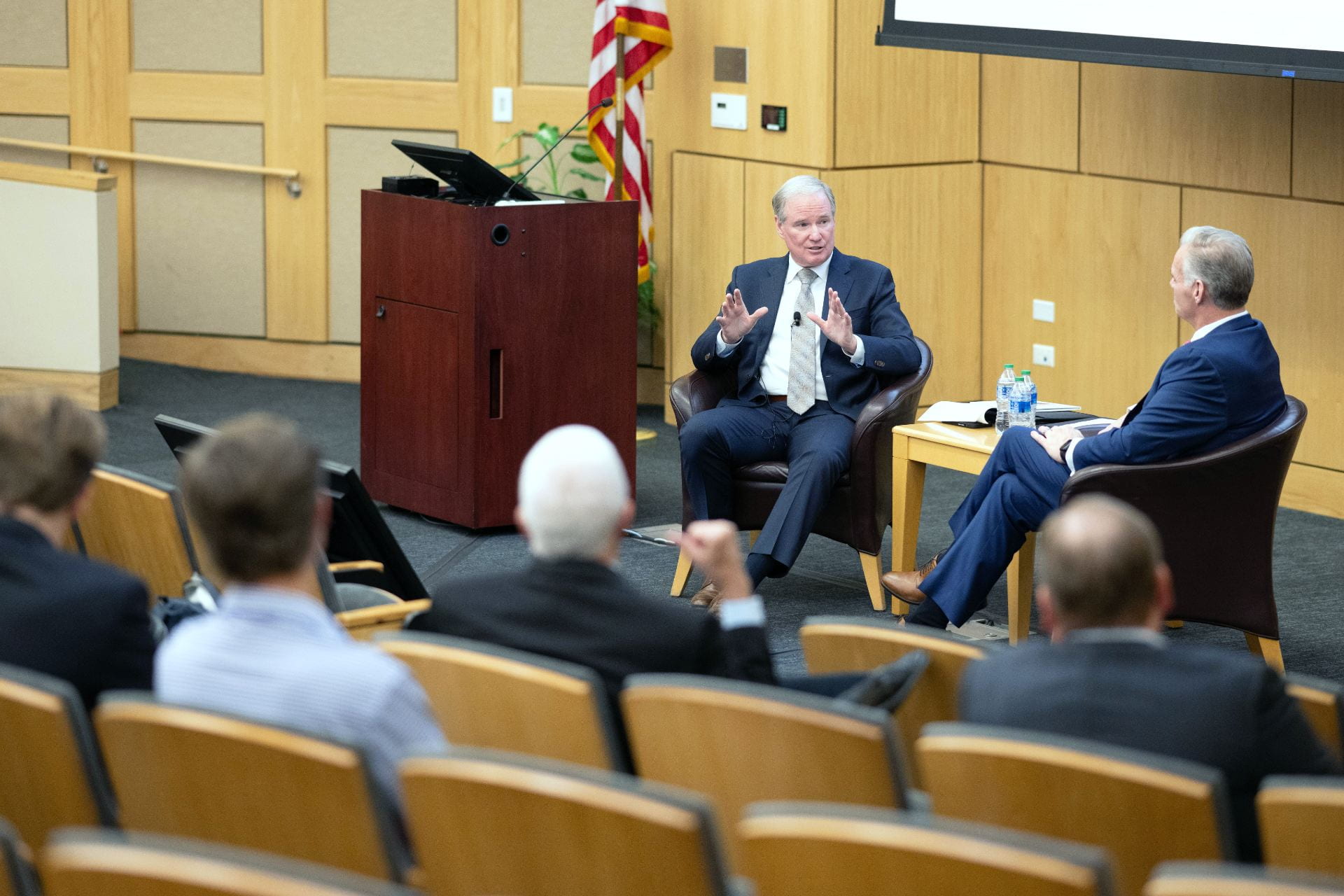The energy industry is in the middle of a generational change. If it wasn’t already, legislation in the form of the Inflation Reduction Act, paired with a shifting cultural and geopolitical landscape, has made that abundantly clear in recent months. As the cost of oil and gas as well as climate change continues to push the sector into daily conversation, it’s time for key stakeholders to come together for their own discussions.
That’s what will happen in February when the SMU Cox Maguire Energy Institute hosts an energy symposium at the George W. Bush Presidential Center. The symposium, titled “Energy Outlook ’23: Stewarding a Sensible Energy Future,” will serve as a rare gathering of stakeholders including large consumer organizations, producers and investors. They will discuss not just the impact of legislation but the future of energy, assessing the right mix of renewables versus traditional fossil fuels, the timelines and promise of new technologies, how the U.S. is positioned within the geopolitical landscape and the state of the capital markets.
“Many factors are interacting to determine what the energy future looks like,” says Bruce Bullock, director at the Maguire Energy Institute. “It has to be sensible; people need to be able to afford it. From a physics standpoint, it needs to be doable. And at the same time, it needs to protect the environment. So, everybody has different expectations, and somehow we have to get them in a room and talk about what we can get done, what we can get done easily, and what we can get done economically.”

Navigating Fossil Fuels vs. Renewables
Of chief concern for so many in the energy industry right now is the transition to renewable energy, including wind and solar. Currently, 19.8% of U.S. energy comes from renewables. President Joe Biden has set a goal to reach 100% carbon pollution-free electricity by 2035.
The path will be a difficult one, with challenges ahead in the form of infrastructure, affordability and reliability concerns. The current vehicle market is exposing some of the cracks, as private and public industry alike are using high gas prices as a jumping-off point to spur movement toward electric vehicles. But concerns lie there as well. With California setting a precedent by saying they’ll ban the sale of new gas-powered cars starting in 2035 and other states likely to follow suit, there’s an urgent need to add more energy capacity to the system — whether in the form of fossil fuels or renewables. (Meanwhile, the country’s aging power grid offers its own challenges, as maxed-out wires have caused blackouts.)
The war between Russia and Ukraine has further muddied the waters. Energy-rich Russia has shut off western Europe from gas supply, causing countries in the region to seek supply elsewhere. With demand soaring, gas prices have remained high, and several countries have turned back to coal.
“What we want as a consumer is for energy to be cheap. We want it to be reliable. We want it to be plentiful. That was the original calculus,” says Ken Hersh, president and CEO of the George W. Bush Presidential Center. “Then we wanted it to be clean. Then we wanted it to be domestic. And I can get you maybe three of those, but I don’t know if I can get you all five.”
Positioning the U.S. as a Leader
Hersh, who is co-founder and former CEO of NGP Energy Capital Management, says the U.S. is currently missing an opportunity. Rather than invest solely in the energy transition, he’s interested in leveraging the country’s position as the world’s largest oil and natural gas producer to encourage the domestic industry.
“The United States has a really wonderful opportunity to lead both,” Hersh says. “I think the mistake that’s being made is that we are leading by saying we want to emphasize alternatives while we really hurt traditional, when what we should be doing is maintaining an emphasis on traditional while we build up our alternatives.”
In this way, Hersh likens the shift to an organization transitioning to a new enterprise resource planning, or ERP, system, the software on which a company manages its day-to-day. Turning off the old before you’ve turned on the new would create mayhem. “In fact, you’d run them in parallel for a really long time before you drop one and start the other,” Hersh says. “And we are not doing that when it comes to energy. We think it’s a flip of the switch.”
Even amid what he sees as a missed opportunity, Hersh finds the U.S. to be well- positioned within the larger geopolitical landscape. It is the world’s largest producer and consumer of primary energy. “The United States is as important as any energy exporter in the world,” he says. “We’re a major exporter of natural gas. We’re a major exporter of refined products. We’re an importer of crude oil. We’re an exporter of gas liquids and chemicals. So we’re incredibly important on both sides of the equation.”

The Promise of New Technology
Another area top of mind across the industry currently is how innovation could play a role in the future of energy. The symposium will explore some of the areas of promise.
“There are new technologies for oil and gas, new technologies for renewables, new technologies for hydrogen, for nuclear and for other sources of energy that we haven’t even imagined yet,” Bullock says. “So, we want to explore some of them.”
When it comes to renewables, Hersh is keeping a keen eye on how battery storage technology progresses over the next decade. With wind and solar being intermittent energy resources — meaning they only generate power when the wind is blowing or the sun is shining — the industry is trying to find a storage solution that allows even distribution of the power over time. While battery storage offers promise, Hersh and others are concerned about the heavy reliance on materials like lithium, cobalt, and rare earth materials. “If we’re not careful, what we could do is shift the problem from reliance upon Middle East oil to Russian natural gas to Chinese lithium,” he says. “Right now, 90% of lithium processing in the world is in China.”
Long term, Hersh expects nuclear to emerge as a viable solution to our energy problems. Small-scale nuclear reactors could eventually provide abundant, low-carbon electricity, although safety and expense issues remain. “By processing and re-processing nuclear waste, you’re getting it down to a very manageable level,” Hersh says. “I think that’s going to be the big winner, but those have 20-year lead times. Near term, I’m bearish, but long-term, I’m bullish.”
While much of the discussion on innovation around the industry centers on renewables and nuclear, Bullock points out improvements in capturing carbon out of the air, a win for oil and gas. “There are more and more projects going in to actually capture the carbon and inject it underground,” he says. “There are a lot of different ways to skin the cat.”
The Maguire Institute’s Role
After more than half a decade of downturn in the industry, Bullock says that part of the industry’s challenge is now gaining back the trust of investors. They’ve been burned before by over-production that sent prices toppling, compounded by pandemic woes. Although the oil and gas sector has rebounded in the last year or two, Bullock says there’s still work to be done to regain confidence.
“Attracting capital to the sector is vital — natural gas is going to have to play a huge part in the future,” he says. “One of the reasons for that is that wind and solar can only handle so much of the load in terms of the electric grid, we’re talking 30%, maybe up to 40% at certain times. So we’ve got to do something both to produce more natural gas and encourage more natural gas generation.” That job begins with educating the public, a failure of the industry in the past, Bullock says, but there have been strides as of late. “I think we’ve got peoples’ ears now,” he says.
The goal for February’s symposium is for it to be about more than education. Bullock is hoping the conversations turn into action. “I would like a half a dozen — six ideas,” he says. “If we can identify five or six actionable ideas that consumers, producers and the financial markets agree upon and will push forward, I think it will have been a success.”
For more information about the symposium or how you can get involved with the Maguire Energy Institute, go to smuenergyoutlook.com.
SMU Cox Maguire Energy Institute, in collaboration with George W. Bush Presidential Center, presents:
Energy Outlook ’23: Stewarding a Sensible Energy Future
Feb. 15-16, 2023
Symposium Sponsors (as of Feb. 1, 2023)
Flagship
William S. Spears Institute for Entrepreneurial Leadership at SMU Cox, generously donated by Dr. William S. Spears
Diamond
Dian Graves Owen Foundation
Hunt Consolidated, Inc
Pioneer Natural Resources
Pitts Oil/Dallas Production Company
Platinum
David B. Miller Family Foundation & Katy and Kyle Miller Family Foundation
ExxonMobil
Hospitality Sponsor
Credit Suisse
Gold
Eagle Oil & Gas Co.
EQT Corporation
Helmerich & Payne, Inc.
HOG Resources
KPMG
Luther King Capital Management
The Sheffield Family
Silver
AG Hill Partners, LLC
Five States Energy
HighPeak Energy
The Hoglund Foundation
Dr. Bobby B. Lyle
Carter Montgomery/Jim Wicklund
Petro-Hunt, LLC
Plains All American
Rhys J. Best and Texas Pacific Land Corporation
Sagefield Capital
Select Energy Services
Tailwater Capital, LLC
Vistra
Bronze
EnCap Flatrock Midstream
Guggenheim Securities
HEYCO Energy Group, Inc.
Marietta College – Center for Earth, Energy and Environment
Merit Advisors
Munsch Hardt Kopf & Harr, P.C.
Principle Services LLC
Range Resources Corporation
Scout Energy Partners
WaFd Bank
Marketing Partners
MarketScale
Sewell Automotive Companies
Energy Media Partner
Energy Intelligence














